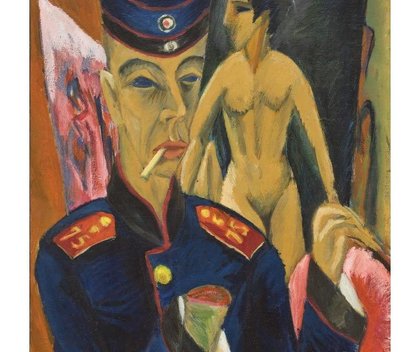Visit the AMAM
Enjoy the intimate setting of an acclaimed college art museum.
Learn MoreThe Allen presents changing exhibitions along with engaging guest speakers and public programs.
Learn MoreThe Allen's collection is particularly strong in 17th century Dutch and Flemish painting, Japanese prints, early modern art, African art, and more.
Learn MoreExplore the full range of museum programs through free events, guided and self-guided tours, and resources for professors and PreK-12 teachers.
Learn MoreResources
Find podcasts, activities, and information for all age groups.
Support for the museum continues our tradition of bringing art to the people.
Learn MoreFebruary 3 - July 19, 2009
In South Ambulatory
February 3 - July 19, 2009
In South Ambulatory

Ernst Ludwig Kirchner’s Self-Portrait as a Soldier and four powerful self-portraits by Max Beckmann serve as the focal point of this exhibition of primarily drawings and prints dating from about 1910 to 1925. The emotional drama and psychological intensity of the works on view—underscored by Kirchner’s disturbing vision of himself as a soldier with his painting hand chopped off—suggests the increasingly varied ways artists sought to express the human condition.
Also on view are early Symbolist and Jugendstil explorations by Edvard Munch, Wassily Kandinsky, and Gustav Klimt alongside highly expressive graphic works—some of them direct responses to World War I—by German artists Erich Heckel, Max Pechstein, Karl Schmidt-Rottluff, and Käthe Kollwitz. After the war, a younger generation of artists such as Otto Dix and George Grosz followed a new path of social criticism in powerful explorations of the brutality of war.
Exploiting a wide range of themes—portraiture, cityscapes, the circus or variety-hall, and religious imagery—these artists sought to communicate a deeper understanding of the world around them. “Art,” Paul Klee famously wrote in 1920, “does not reproduce what is visible, but makes things visible.”
Curated by Abbe Schriber ’09 and AMAM Director Stephanie Wiles
AMAM Director
Visit - Tours
Enjoy the intimacy of one of the nation's best academic art museums. Free admission since 1917.
Newsletter
Sign up for our e-newsletter to get information about our free events and latest exhibitions.
Join & Support
Your support makes a difference. Become a museum member, donor, or volunteer.